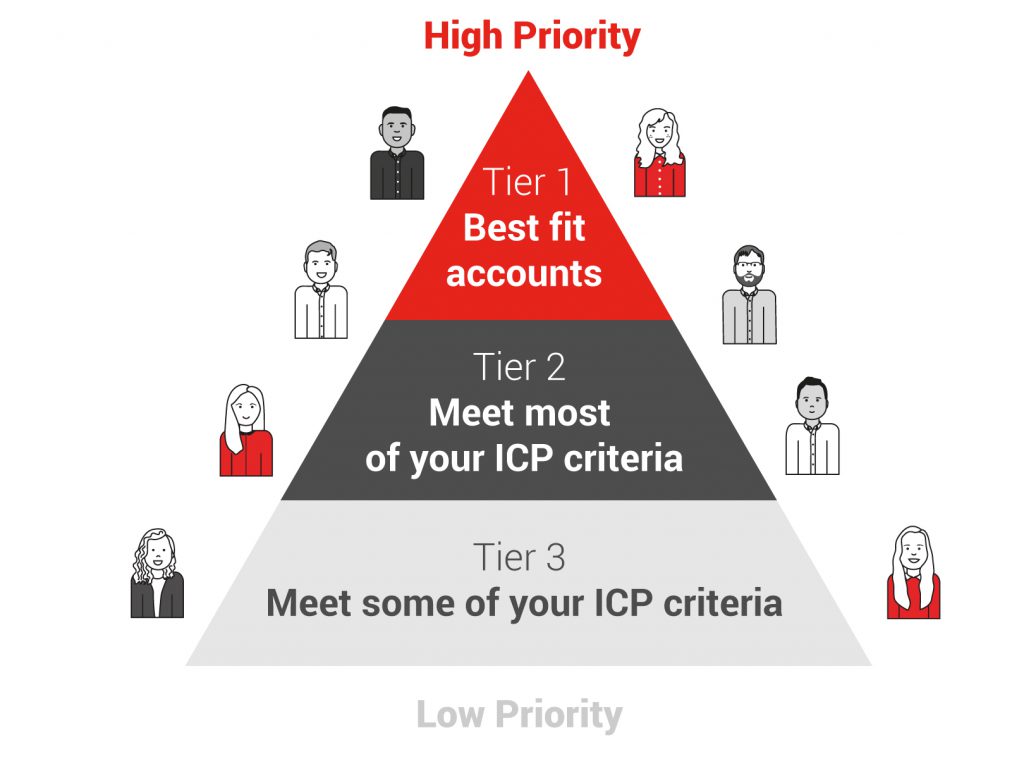Account selection is the most critical step in Account-Based Marketing (ABM) – yet 39% of B2B marketers say determining which accounts to target is one of their biggest ABM challenges.
This is according to our first party research conducted among 200 senior B2B marketing professionals in our Insights for Professionals (IFP) community.
Building an effective Target Account List (TAL) sets the solid foundations required for a successful Account-Based Marketing process. Get this wrong, and you risk setting yourself up for failure from the word go. It’s therefore vital to apply a structured process to your TAL to get it right first time.
Any successful B2B campaign needs to deliver commercial results, so it’s key for both Marketing and Sales teams to focus on target accounts – those which are most likely to invest in your product or service. However, narrowing these down is where many businesses fail. How do you define your strategic accounts when all of them have the potential to convert?
What is a target account list?
A Target Account List (TAL) is a vital component in Account-Based Marketing (ABM), comprising a carefully curated list of qualified organizations that a company aims to convert into customers. These accounts are typically identified based on their high revenue potential and alignment with the company’s Ideal Customer Profile (ICP). This strategic list serves to streamline the company’s marketing and sales efforts, enabling a more focused approach towards high-converting prospects. The TAL also plays a crucial role in customizing and personalizing marketing initiatives – improving customer acquisition and fostering stronger business relationships.
10 steps to building your target account list
Take a look at our 10 steps to building the perfect TAL to enhance your Account-Based Marketing campaign:
Reading time: 5 minutes
Step 1: Determine your Account-Based Marketing (ABM) strategy
First and foremost, you need to establish your ABM strategy. There are three different strategies that affect how you go about your campaign:
- One-to-one: targeting individual key accounts
- One-to-few: targeting small groups of key accounts, rather than individuals
- One-to-many: targeting a total addressable market.
But which type of account-based marketing strategy should you adopt? Used by 35% of marketers, the one-to-few strategy is the most common as it allows you to put your Account-Based Marketing approach into place with a wider range of contacts based on predictive analysis and industry knowledge. However, our data shows that a combined ABM approach (also used by 35% of marketers) is just as popular, likely due to the ability to target a wider array of potential customers.
Whichever strategy you choose, you shouldn’t allow your list of prospects to grow without good reason. Remember that the point of ABM efforts is to focus on your highest-converting accounts only.
Its vitally important to ensure that the marketing resources, channels and initiatives utilized to attract and engage high-value accounts are optimized for first-time accuracy, enabling sales reps to intervene and convert them effectively. Sales and Marketing alignment is crucial as it enables sales teams to understand the origin of MQLs in terms of their interaction with content and entry channels, providing a clearer picture of the customer journey and funnel stage in order to optimize their conversion strategy.

Step 2: Create your Ideal Customer Profile (ICP) and enrich with technographic data
Your Ideal Customer Profile (ICP) needs to be a clear, categorical description of target customers who would benefit the most from your offering, and who are most likely to make a long-term investment with you. This in turn represents the type of customer you want to focus on, giving you direction when building your TAL. If you get this right, you can focus resources on higher quality leads and improve the return on investment for your campaign.
When defining your ICP, consider the following:
- Company size: What company size is the best fit for your offering?
- Industry: Which industry or industries are you targeting?
- Geography: Where are your ideal customers located?
- Budget: What is the typical budget of your ideal customers?
- Technographics: What technologies do these target companies currently use or require?
Integrating technographic data into your ICP is essential. It allows you to understand the technological profile of your ideal customers, including their current tech stack, software preferences, and future tech needs. This data can position your offering as the solution to their tech challenges or as an enhancement to their existing technology environment.
Remember that your ICP is not the same as your buyer persona. An ICP is the type of company you should be targeting, while a customer persona is a detailed analysis of the people who buy from you. Customer personas are extremely useful too, but you can’t develop effective personas without a broader understanding of the types of B2B companies they work for, so your ICP should always come first. The inclusion of technographic data in your ICP provides a more nuanced understanding of your targets, shaping a more strategic and informed ABM approach.
Step 3: Obtain accurate, quality data
Before you can focus on target segments, your Marketing team first need to make sure that any existing data held is accurate. With ABM campaigns relying so heavily on data, there is no room for error.
Segmentation will only work if you have a high quality, precise and concrete ABM list. This is where data accuracy, data formatting and an understanding of data cleansing are important. With 54% of marketers using both first and third-party data, you need to be able to verify quality. Even having wrong contact names, out of date stats or undocumented changes in business requirements can have a detrimental effect on your ABM strategy.
Step 4: Segment your list of accounts
In the segmentation stage, firmographic data such as geographic location, industry, types of business, number of clients or technologies used can all be used to categorize relevant target accounts.
Further segmentation can be defined by breaking down your list of prospects based on the amount of work required to nurture them through to conversion. You are aiming for the highest reward using minimal resources. You can also look at segmenting companies based on how easily they can adopt your product or service, or how quickly they will benefit from them.
Once you have meaningful segments defined, they need to be regularly checked for viability so that as your project moves forward, the validity of segmentation results – and consequently your TAL – remains as accurate as possible.
Step 5: Consider third-party data
Third-party demographic and firmographic data is essential for building look-a-like strategies. A tactic used by 83% of marketers, Look-a-like Marketing can be useful for Marketing leaders looking to find new target audiences to further build out their list of companies and reach new clients.
You can also assess the suitability of individual accounts in terms of proximity. Depending on your industry, this may or may not be a viable way to build your TAL. If geographic location is an important characteristic, you can map out companies based on their location and consider a local approach when creating your ABM list.
Step 6: Utilize Tiers for prioritization
Using your ICP, you can make a structured list of target accounts. These are typically, Tier 1, Tier 2 and Tier 3 – known as the Three-Tiered Strategy – and are based on priority.
- Tier 1– these are the best-fit accounts according to your ICP, and they must have demonstrated intent to do business with your company. They may also be the types of companies that you can easily cross and upsell your services to. One-to-one strategies will likely focus solely on Tier 1 accounts.
- Tier 2 – these accounts meet most of your ICP criteria and have demonstrated buyer intent. A Tier 2 account may be in the right geographical location, the right industry and have shown interest in you, but they may be smaller than your ideal company size in terms of average deal size and revenue. Therefore the types of business considered is a key factor.
- Tier 3 – these are the accounts that only meet some of your ICP markers, but have demonstrated intent by visiting your website, downloading your content or signing up to a newsletter. Generally, these are lower priority targets rather than priority accounts.

Every company’s tier list will be defined differently, so it’s important to know exactly what you’re looking for in your priority accounts and why. This is what makes the ICP so important. For example, if your main goal is to win over Fortune 500 businesses, Tier 1 could be any company in the Fortune 500 list, Tier 2 could be companies in the Fortune 1000 list, and Tier 3 could be any other company in the same industry but not within the list.
Step 7: Establish ABM list ownership
A vital step that is often overlooked is having a designated ABM list owner. The most successful, results-driven Account-Based Marketing approach thrives on organizational alignment and accountability. Having a point of contact for your Target Account List prevents the common pitfall of having too many cooks in the kitchen. Although a round table approach is helpful, one person should have ownership and be regarded as the key decision maker.
Step 8. Aligning sales and marketing teams
The key to a successful strategy lies in the seamless alignment between sales and marketing teams. Collaboration is paramount; these teams must forge a partnership to identify high-value target accounts, create personalized content tailored to those accounts’ specific needs, and closely monitor engagement to understand what resonates. It’s essential for sales and marketing to exchange insights and feedback continuously, allowing for the iterative refinement of strategies.
To facilitate this process, both teams should engage in regular meetings, maintain transparent communication, and commit to shared objectives – ensuring they are moving in lockstep towards common goals. This synergy is not just about ensuring the right message is delivered at the optimal moment; it’s about cultivating a cohesive approach to nurturing potential leads and guiding them towards conversion with a unified voice and strategy.
Effective alignment transforms the relationship between sales and marketing into a powerful, integrated force. In the context of ABM, where targeted, personalized interactions are at the forefront, this collaboration is crucial. When the two teams operate in harmony, they become a driving force behind sustainable business growth and customer acquisition.
Step 9: Select the right tech stack for your ABM
When building a robust ABM list, the significance of the right technology stack can’t be overstated. This step is less about hastily acquiring expensive new technologies and more about conducting a strategic review of your current sales, marketing, and CRM systems. The objective is to ensure that these tools are in sync with your ABM strategy’s developmental stage, specific goals, and financial parameters.
For a well-rounded ABM tech stack, consider the following key components:
- Account enrichment platforms: Use these platforms to keep your account data current and comprehensive. They should enable you to systematically update and enrich the information you have on potential accounts, which is critical for maintaining the efficacy of your ABM campaigns.
- Intent data tools: Implement tools such as Bombora to track and analyze digital footprints, which helps in understanding the interests and intents of your target accounts – providing a clear advantage in engagement strategies. Inbox Insight can seamlessly do this for you – capturing in-market demand by syndicating your content to audiences with high intent.
- CRM systems: Employ CRM solutions like HubSpot for their sophisticated targeting capabilities and personalization features. These systems are vital for organizing, segmenting, and engaging with your TAL effectively.
- Prospecting platforms: Incorporate services like LinkedIn Sales Navigator for precise targeting and outreach. These platforms are instrumental in identifying and connecting with the right decision-makers within your target accounts.
When these elements are thoughtfully integrated, they create a synergistic ABM tech stack that can facilitate personalized, efficient, and responsive marketing efforts – the deployment of which is paramount in executing a successful ABM strategy.
Step 10: Engaging and nurturing target accounts
- Customized material: Use content generation tools, such as dynamic alternative PDF creators, to produce content that is directly related to each account’s unique challenges and requirements.
- Engagement across multiple platforms: Employ a diverse mix of platforms, including email, social networks, direct correspondence, and InMail, to interact with your key accounts.
- Influence through expertise: Disseminate industry knowledge and authoritative content to position your brand as a thought leader in your sector.
- Virtual gatherings and webinars: Organize online functions and webinars to provide your key accounts with useful knowledge.
- Targeted account advertising: Utilize specialized advertising to connect with your key accounts via platforms like LinkedIn, Google, and other industry-relevant websites.
Ready to build your ABM list?
Building an effective ABM list for your target accounts is critical to ABM success, setting out solid foundations from which your Account-Based Marketing efforts can thrive. Focusing on those accounts with the greatest potential to convert is what will see the greatest results.
Unsure where to begin? Partner with an Account-Based Marketing provider and claim your free ABM Target Account List today.






